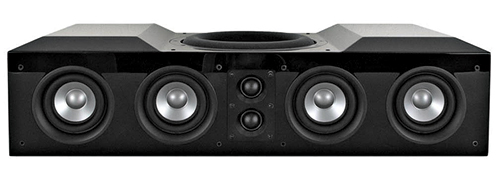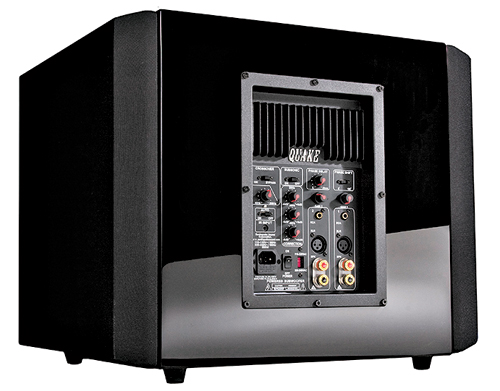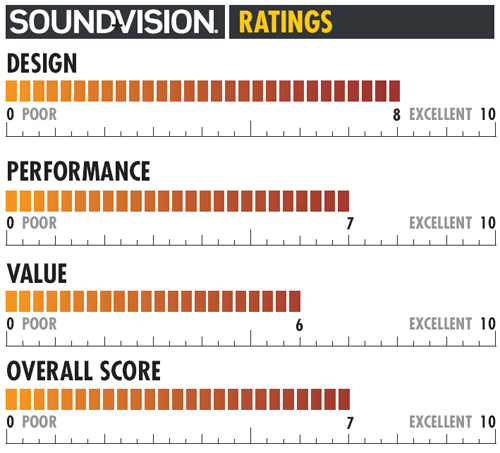Earthquake Sound Titan Telesto Speaker System Page 2
PERFORMANCE
Whatever the technical explanation, the new setup was key to improving the Earthquake's performance. The Telestos are obviously fullrange speakers, and that's how I began listening to them with stereo music after a week's worth of casual use. While the low-frequency excesses had been tamed, the towers still had a warm, powerful presentation, with low end extending well below 40 Hz - the usual province of subwoofers. Organist Jean Guillou's unique transcription of Mussorgsky's Pictures at an Exhibition (on a Dorian CD) makes extensive forays into these near-infrasonic depths, and the Earthquakes happily delivered foundation-trembling results without complaint or obvious doubling - impressive.
My next discovery was that the Telesto is one of those designs that sound better the louder you play it. The Drum Record CD from Sheffield Labs, a long-out-of-print classic, features the great rock drummer Jim Keltner ranging far and wide on his kit, solo, meticulously miked and breathtakingly recorded. This disc has about 20 dB more dynamic range than typical pop drums, and sounds truer to life than any other recorded traps I've heard. Only a few speakers I've encountered have managed to sound closer to live at actual live volumes than when played, say, 10 dB less, but the Earthquake is one such example. (I play with a pretty good rock drummer. He may be no Jim Keltner - sorry, Brian - but I do play with him every week, so I know what I'm hearing.)
Otherwise, the Earthquake towers' timbral presentation was highly accurate. Male vocals sounded open and natural; massed strings retained excellent bite and attack despite having a touch of extra warmth, and the "edge" on brass attacks remained impressively intact. The Telestos' stereo soundstage was tight and quite broad, though the illusion of depth was fairly modest.

Earthquake's unusually laid-out center speaker proved similarly capable in terms of its range and dynamics. Indeed, the PN-4421 was able to absorb more clean power while continuing to deliver the dynamic goods than any but two or three other dedicated-center designs I've encountered. That said, it's tonal performance was less uniformly successful. Midrange and treble dispersion was very tight, especially vertically, so a listener more than one seat or so off from the dead center sweet-spot (or just a head taller) may hear noticeably less crisp and articulate sound. In any case, tilting the PN-4421 for dead-on vertical aim was imperative. But even when ideally positioned, center sound, especially on deeper male voices, was distinctly different from the Telesto towers' presentation: bassier, a bit "chestier," and perceptibly less open and airy.
The whimsical family film Inkheart's Dolby TrueHD soundtrack on Blu-ray Disc may be an imperfect production, but it's dense and layered aplenty. A good system will expose its faults - some overtly "studio-sounding" dialogue, and a flatness of impact - all too well. The Earthquake suite had no difficulty conveying these aspects, and all but laughed at its demands for dynamics and level.
Earthquake's lit lists the PN-2421 as a "dipole speaker system," but it didn't sound very dipolar to me; there was little audible on-axis null at any frequencies. Subsequent checks using hightech gear (a 9-volt battery and a couple of alligator clips) revealed that the dual woofers were indeed in phase, at least at 0 Hz (DC). And sweeping the PN-2421 with tones suggested they remain inphase at other frequencies, too. While the tweeters may well have been antiphase, this does not a dipole make in my book. Nonetheless, the Earthquake surrounds, which I would qualify as more or less "bipolar," did a perfectly good job of maintaining what spaciousness and ambience Inkheart had to offer, and indeed displayed no shortcomings on far more demanding stuff, too. They produced nicely broadened ambience, and matched up well with the Titan towers on rear-panning swoops and zooms.
The system's front-stage delivery, however, suffered from a tonal discontinuity between front and center speakers: In the climactic scenes from Inkheart in which fantastical things are whizzing busily across the town square, I couldn't help keying on the shift in timbres as whooshes handed off to the center speaker.

Better news awaited from the Earthquake Earthquake sub. The enormous Supernova MKVI-15 produced deep bass that was, well, enormous, taking its place alongside perhaps four other subs I've tested that have delivered effectively endless deep bass below 30 Hz, at levels exceeding my room's needs. The avalanche scene from XXX is one of my deep-bass bastions, and the MKVI-15 shook the building to an alarmingly convincing degree without a hint of strain, audible port noise, or unintended boom. Close inspection, though, did reveal one MKVI-15 shortcoming: background noise. Whenever powered on, the sub produced steady filtered-noise a few dB above the ambient background of a seriously quiet listening room. This was barely audible at the listening position during dead-silent pauses of things like carefully produced chamber music CDs, but only if I strained for it with every fiber.

BOTTOM LINE
For demanding listeners who seek a full-range tower with honest tonality, impressive dynamics, and a "something-different" look, the Titan Telesto towers are a strong candidate. The MKVI-15 sub plays in the same league: Few other standalone woofers can do the same job, and most of these reside in the same lofty price range. The quite competent PN-2421 surrounds were nicely complementary, but the PN-4421 center speaker, while impressive, might profitably yield to a closer timbral match from another speaker line. Otherwise, I was mightily impressed by this big Earthquake system. It's nice to see an American firm marching to its own drummer, and coming up with a winner.








































